Topoisomerase I Inhibitors in Small-Cell Lung Cancer
Among patients with lung cancer, approximately 15% have smallcelllung cancer (SCLC). The clinical characteristics of SCLC tend tobe more aggressive, but also more sensitive to chemotherapy and radiationtherapy than those of non-SCLC. Irinotecan (Camptosar) is aderivative of camptothecin, an inhibitor of the nuclear enzymetopoisomerase I. Irinotecan has been shown to exhibit excellent antitumoractivity against SCLC in monotherapy regimens and in combinationwith cisplatin. A phase III trial comparing irinotecan and cisplatin(IP) with etoposide and cisplatin (EP) in patients with previously untreatedextensive-stage SCLC (ED-SCLC) was conducted. Patients inthe IP arm responded significantly better than patients in the EP arm.In the IP arm, the response rate was 84%, and median overall survivalwas 12.8 months. A phase II trial of irinotecan, cisplatin, and etoposide(IPE) administered weekly (arm A) or every 4 weeks (arm B) for EDSCLC(JCOG 9902-DI) was also performed. In arm B, the responserate was 77% and the median overall survival was 12.9 months. A randomizedtrial comparing IP with IPE administered every 3 weeks inpatients with previously untreated ED-SCLC is presently being performedin Japan.
ABSTRACT: Among patients with lung cancer, approximately 15% have smallcelllung cancer (SCLC). The clinical characteristics of SCLC tend tobe more aggressive, but also more sensitive to chemotherapy and radiationtherapy than those of non-SCLC. Irinotecan (Camptosar) is aderivative of camptothecin, an inhibitor of the nuclear enzymetopoisomerase I. Irinotecan has been shown to exhibit excellent antitumoractivity against SCLC in monotherapy regimens and in combinationwith cisplatin. A phase III trial comparing irinotecan and cisplatin(IP) with etoposide and cisplatin (EP) in patients with previously untreatedextensive-stage SCLC (ED-SCLC) was conducted. Patients inthe IP arm responded significantly better than patients in the EP arm.In the IP arm, the response rate was 84%, and median overall survivalwas 12.8 months. A phase II trial of irinotecan, cisplatin, and etoposide(IPE) administered weekly (arm A) or every 4 weeks (arm B) for EDSCLC(JCOG 9902-DI) was also performed. In arm B, the responserate was 77% and the median overall survival was 12.9 months. A randomizedtrial comparing IP with IPE administered every 3 weeks inpatients with previously untreated ED-SCLC is presently being performedin Japan.
An estimated 75,000 new casesof lung cancer were diagnosedin Japan in 2002. Approximately15% of these cases were diagnosedas small-cell lung cancer(SCLC), which is strongly associatedwith tobacco use, as is non-small-celllung cancer (NSCLC). The clinicalcharacteristics of SCLC tend to bemore aggressive, but also more sensitiveto chemotherapy and radiationtherapy than those of NSCLC. Smallcelllung cancer is usually staged aseither limited disease (LD) or extensivedisease (ED).[1]Platinum-based chemotherapy remainsthe mainstay of treatment regimensfor ED-SCLC. In a metaanalysisof 19 randomized trials comparinga cisplatin-based regimen witha non-cisplatin-based regimen, patientsrandomized to a regimen containingcisplatin had a significantlyhigher probability of response andsurvival, with no significant increasein toxicity.[2] Berghmans et al presenteda detailed analysis of the rolesof etoposide and cisplatin in the treatmentof SCLC.[3] Between 1980 and1998, 36 eligible trials were performed.These trials concluded thatthe use of cisplatin and/or etoposideoffered a significant survival advantageto patients with SCLC.Irinotecan (Camptosar) has beensemisynthesized as a water-solublederivative of camptothecin, an inhibitorof nuclear enzyme topoisomeraseI, in an attempt to reduce its toxicityand to improve its therapeutic efficacy.[4-8] In a phase II trial of irinotecanfor SCLC, the response rate was47%.[9,10] In preclinical studies,irinotecan and cisplatin exhibited synergisticactivities. Their toxicity pro-files also showed a minimal overlap.[11-16] In a phase II trial of irinotecanand cisplatin, the response ratewas 86%.[17] In these trials, the principaltoxicities were neutropenia anddiarrhea.

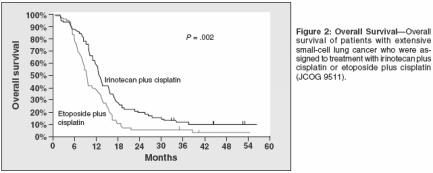

Phase III Trial ComparingIrinotecan and Cisplatin WithCisplatin and EtoposideBased on the results of the phase IItrial, the Japan Clinical OncologyGroup (JCOG) conducted a multiinstitutionalrandomized phase III trial(JCOG-9511) comparing irinotecanand cisplatin (IP) with cisplatinand etoposide (EP) in patients withpreviously untreated ED-SCLC.[18]The patient characteristics in this trialincluded an Eastern Cooperative OncologyGroup (ECOG) performancestatus of 0-2 and age ≤ 70 years.Patients with symptomatic central nervoussystem metastases requiring radiationor corticosteroid treatmentwere excluded from the trial. The experimentalarm consisted of irinotecanat 60 mg/m2 administered on days1, 8, and 15 of each 4-week cycle,along with cisplatin at 60 mg/m2 administeredon day 1 for a total of four4-week cycles (IP). This treatment regimenwas compared with a regimenof etoposide at 100 mg/m2 administeredon the first 3 days of each3-week cycle along with cisplatin at80 mg/m2 administered on day 1 for atotal of four 3-week cycles (EP).The principal end point was overallsurvival. The projected accrual forthis trial was 230 patients (115 patientsper arm). An interim analysisconducted after 77 patients had beenaccrued in each arm showed a significantsurvival advantage for the IParm. Therefore, further enrollment inthe trial was discontinued.The response rate was significantlyhigher in the IP arm than in the EParm (84% vs 68%; P = .02). Additionally,the IP arm showed a statisticallysignificant improvement in bothprogression-free survival (6.9 vs 4.8months; P = .003) (Figure 1) and medianoverall survival (12.8 vs 9.4months; P = .002) (Figure 2).The results of this trial were themost exciting to be seen in patientswith previously untreated SCLC. TheIP regimen is thus another platinumbasedcombination that should be consideredfor the treatment of ED-SCLC.Appropriately, the combination of cisplatinand irinotecan has become thenew standard treatment for patientswith ED-SCLC in Japan. However,several points must be examined beforethe IP regimen can be fully establishedas the new standardtreatment for ED-SCLC. Three randomizedcontrolled trials comparingthe EP regimen with the IP regimenare presently under way in Europeand the United States.
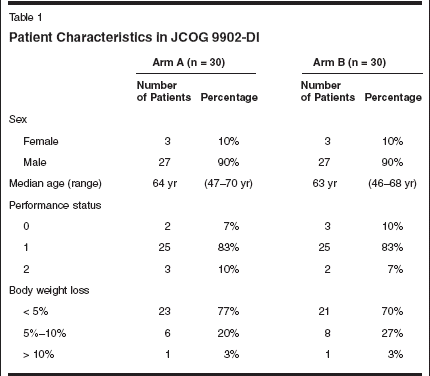
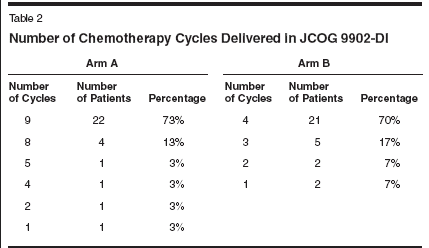


Phase II Trial of Cisplatin,Irinotecan, and EtoposideAdministered Weekly orEvery 4 WeeksJCOG 9511 showed that the IP regimenwas significantly better than theEP regimen. However, because etoposidewas still considered to be akey drug in the treatment of SCLC, acombination of these three drugs-irinotecan, cisplatin, and etoposide(IPE)-seemed to be a promisingstrategy for the treatment of EDSCLC.The recommended weeklydoses (JCOG 9507) and the dosagesfor each 4-week cycle (JCOG 9512)for IPE were decided using dose-escalation trials. For these reasons, aphase II trial of irinotecan, cisplatin,and etoposide administered weekly orevery 4 weeks for ED-SCLC (JCOG9902-DI) was performed.[19]The purpose of this trial was toevaluate the toxicity and antitumoreffect of the combination of irinotecan,cisplatin, and etoposide administeredaccording to two schedules,weekly (arm A) and every 4 weeks(arm B), for the treatment of previouslyuntreated ED-SCLC, and to selectthe appropriate arm for use inphase III trials. Patients were enrolledin this trial if they met the followingcriteria: (1) a histologic or cytologicaldiagnosis of SCLC; (2) no prior treatment;(3) measurable disease; (4) extensivedisease, defined as distantmetastasis or contralateral hilar lymphnode metastasis; (5) performance statusof 0 to 2 on the ECOG scale; (6) alife expectancy of 3 months or longer;(7) age between 20 and 70 years;(8) adequate organ function; and (9)written informed consent.The treatment schedule is shownin Figure 3. In arm A, cisplatin at 25mg/m2 was administered intravenously(IV) over 60 minutes on day 1 andat 1-week intervals for 9 weeks; irinotecanat 90 mg/m2 was administeredIV over 90 minutes on day 1 on weeks1, 3, 5, 7, and 9; and etoposide at 60mg/m2 was administered by IV over60 minutes on days 1 to 3 of weeks 2,4, 6, and 8. Granulocyte colony-stimulatingfactor (G-CSF) was administeredprophylactically on the dayswhen a cytotoxic drug was not given,unless the white blood cell (WBC)count exceeded 10.0 * 109/L.In arm B, cisplatin at 60 mg/m2was administered by IV over 60 minuteson day 1; irinotecan at 60 mg/m2was administered by IV over 90 minuteson days 1, 8, and 15; and etoposideat 50 mg/m2 was administered byIV over 60 minutes on days 1 to 3.G-CSF was injected subcutaneouslyfrom day 5 until the day when theWBC count exceeded 10.0 * 109/L.This treatment was repeated every 4weeks for a total of four cycles.Patient characteristics are listed inTable 1. Between August 1999 andOctober 2000, 30 patients were enteredin each arm. The last follow-upexamination was performed in February2002. All enrolled patients wereincluded in the toxicity, tumor response,and patient survival analyses.No differences in any of the listedcharacteristics were observed betweenthe two arms.Treatment delivery is listed in Table2. Of the 30 patients in each arm,22 (73%) and 21 (70%) patients inarms A and B, respectively, receivedfull cycles of chemotherapy (nine cyclesin arm A and four cycles in armB). Therapy was stopped because oftoxicity in four (13%) patients in armA and in six (20%) patients in arm B.Therapy was stopped because of tumorprogression in three (10%) patientsin each arm. The need fortreatment delay in arm A and treatmentskipping in arm B, however,was significant. Only eight (27%) patientsin arm A completed the treatmentwithout delay, and only seven(23%) patients in arm B received allthe planned doses. A total of 105 chemotherapycycles were administered to30 patients in arm B, but eight (8%)doses of irinotecan on day 8, and 33(31%) doses of irinotecan on day 15were omitted because of toxicity, accordingto criteria in the protocol.The median total dosages of cisplatinand etoposide administered perpatient were maintained at the planneddosage levels in both arms (Table 3).The median total dosage of irinotecanas a percentage of the scheduled dosage(the relative total dosage) was100% in arm A, but only 78% in armB, reflecting the doses of irinotecanthat were skipped on days 8 and 15.Dose intensity was evaluated in 29patients in arm A and 28 patients inarm B (Table 3). The median relativedosage intensity was well maintainedat a level of 80% or higher, exceptthat of irinotecan in arm B (77%).The median actual dosage intensityof etoposide was 70 mg/m2/wk in armA and 37 mg/m2/wk in arm B.
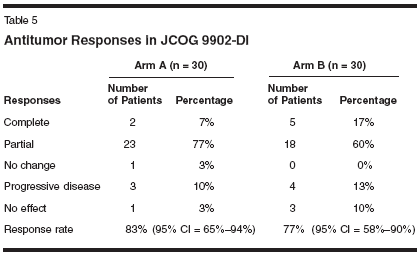
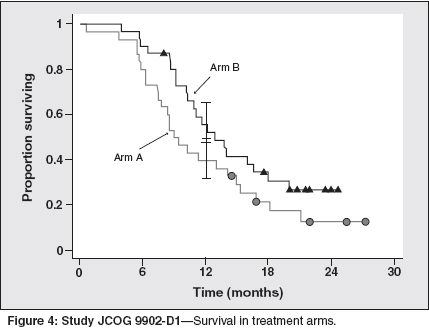
Toxicity was evaluated in all patients.The incidences of grade 3/4neutropenia, anemia, thrombocytopenia,infection, and diarrhea in arm Awere 57%, 43%, 27%, 7%, and 7%,respectively, and 87%, 47%, 10%,13%, and 10%, respectively, in armB. A treatment-related death occurredin one patient in arm A (Table 4).Two complete responses (CRs) and23 partial responses (PRs) were obtainedin arm A, resulting in an overallclinical response rate of 83%,whereas five CRs and 18 PRs wereobtained in arm B, resulting in anoverall response rate of 77% (Table5). The median time to survival and1-year survival rate in arm A were 8.9months and 40%, respectively, and12.9 months and 57%, respectively,in arm B (Figure 4).In this trial, the two IPE scheduleswere both effective against ED-SCLCand had an acceptable toxicity level.Arm B was adopted as the investigationalarm in phase III trials.ConclusionThe combination of cisplatin andirinotecan has become the new standardtreatment for patients with EDSCLCin Japan. However, SCLC israrely cured, although the responserate has been improved and the survivaltime extended through the useof chemotherapy. Based on the resultsof JCOG 9511 and JCOG 9902-DI, a randomized trial comparing IPwith IPE administered every 3 weeksin patients with previously untreatedED-SCLC is now being performed inJapan.
Disclosures:
The authors have nosignificant financial interest or other relationshipwith the manufacturers of any productsor providers of any service mentioned in thisarticle.
References:
1.
Kristjansen PE, Hansen HH: Managementof small cell lung cancer: A Summary of theThird International Association for the Studyof Lung Cancer Workshop on Small Cell LungCancer. J Natl Cancer Inst 82:263-266, 1990.
2.
Pujol JL, Carestia L, Daures JP: Is there acase for cisplatin in the treatment of small-celllung cancer?: A meta-analysis of randomizedtrials of a cisplatin-containing regimen vs aregimen without this alkylating agent. Br JCancer 83:8-15, 2000.
3.
Berghmans T, Paesmans M, Mascaux C,et al: A meta-analysis of the role of etoposide(VP-16) and cisplatin (CDDP) in small cell lungcancer (SCLC) with a methodology assessment(abstract). Eur J Cancer 35(suppl):S248, 1999.
4.
Kunimoto T, Nitta K, Tanaka T, et al:Antitumor activity of 7-ethyl-10-[4-(1-piperidino)-1-piperidino] carbonyloxycamptothecin,a novel water-soluble derivativeof camptothecin, against murine tumors. CancerRes 47:5944-5947, 1987.
5.
Matsuzaki T, Yokokura T, Mutai M, et al:Inhibition of spontaneous and experimentalmetastasis by a new derivative of camptothecin,CPT-11, in mice. Cancer ChemotherPharmacol 21:308-312, 1988.
6.
Tsuruo T, Matsuzaki T, Matsushita M, etal: Antitumor effect of CPT-11, a new derivativeof camptothecin, against pleiotropic drugresistanttumors in vitro and in vivo. CancerChemother Pharmacol 21:71-74, 1988.
7.
Taguchi T, Wakui A, Hasegawa K, et al:Phase I clinical study of CPT-11. Gan ToKagaku Ryoho 17:115-120, 1990. (in Japanese)
8.
Ohno R, Okada K, Masaoka T, et al: Anearly phase II study of CPT-11: A new derivativeof camptothecin, for the treatment of leukemiaand lymphoma. J Clin Oncol 8:1907-1912, 1990.
9.
Negoro S, Fukuoka M, Niitani H, et al:Phase II study of CPT-11, new camptothecinderivative, in small cell lung cancer (SCLC)(abstract). Proc Am Soc Clin Oncol 10:241,1991.
10.
Masuda N, Fukuoka M, Kusunoki Y, etal: CPT-11: A new derivative of camptothecinfor the treatment of refractory or relapsed smallcelllung cancer. J Clin Oncol 10:1225-1229,1992.
11.
Kudoh S, Takada M, Masuda N, et al:Enhanced anti-tumor efficacy of a combinationof CPT-11, a new derivative of camptothecin,and cisplatin against human lung tumor xenografts.Jpn J Cancer Res 84:203-207, 1993.
12.
Masumoto N, Nakano S, Esaki T, et al:Inhibition of cis-diamminedichloroplatinum(II)-induced DNA interstrand cross-link removalby 7-ethyl-10-hydroxy-camptothecin inHST-1 human squamous-carcinoma cells. IntJ Cancer 62:70-75, 1995.
13.
Pei XH, Nakanishi Y, Takayama K, etal: Effect of CPT-11 in combination with otheranticancer agents in lung cancer cells. AnticancerDrugs 8:231-237, 1997.
14.
Masuda N, Fukuoka M, Kudoh S, et al:Phase I and pharmacologic study of irinotecanin combination with cisplatin for advanced lungcancer. Br J Cancer 68:777-782, 1993.
15.
Masuda N, Fukuoka M, Kudoh S, et al:Phase I study of irinotecan and cisplatin withgranulocyte colony-stimulating factor supportfor advanced non-small-cell lung cancer. J ClinOncol 12:90-96, 1994.
16.
Nakagawa K, Fukuoka M, Niitani H, etal: Phase II study of irinotecan (CPT-11) andcisplatin in patients with advanced non-smallcelllung cancer (NSCLC) (abstract). Proc AmSoc Clin Oncol 12:332, 1993.
17.
Kudoh S, Fujiwara Y, Takada Y, et al:Phase II study of irinotecan combined withcisplatin in patients with previously untreatedsmall-cell lung cancer. West Japan Lung CancerGroup. J Clin Oncol 16:1068-1074, 1998.
18.
Noda K, Nishiwaki Y, Kawahara M, etal: Irinotecan plus cisplatin compared withetoposide plus cisplatin for extensive small-celllung cancer. N Engl J Med 346:85-91, 2002.
19.
Sekine I, Nishiwaki Y, Noda K, et al:Randomized phase II study of cisplatin,irinotecan and etoposide combinations administeredweekly or every 4 weeks for extensivesmall-cell lung cancer (JCOG9902-DI). AnnOncol 14:709-714, 2003.